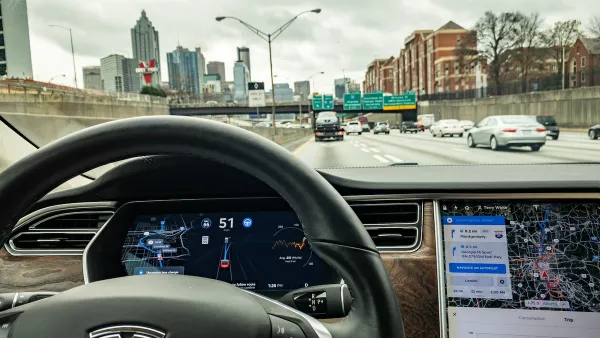Some Tesla autonomous modes direct the vehicle to engage in dangerous and illegal behaviors, prompting calls for increased regulation of autonomous vehicle tech.

According to an article by Streetsblog's Kea Wilson, Tesla is equipping its vehicles with a feature that lets drivers choose "how aggressively the vehicle applies many of its automated safety features on U.S. roads," essentially allowing the car to break common traffic laws under its "assertive" driving mode.
The rollout went largely unnoticed by street safety advocates until a Jan. 9 article in The Verge, when journalist Emma Roth revealed that putting a Tesla in 'assertive' mode will effectively direct the car to tailgate other motorists, perform unsafe passing maneuvers, and roll through certain stops ('average' mode isn’t much safer). All those behaviors are illegal in most U.S. states, and experts say there’s no reason why Tesla shouldn’t be required to program its vehicles to follow the local rules of the road, even when drivers travel between jurisdictions with varying safety standards.
The revelation concerns road safety advocates who say the company is endangering riders and pedestrians by allowing the cars to roll through stops and red lights. Wilson attributes this in large part to the fact that "by and large, U.S. law tends to favor penalizing individual drivers for breaking the law, rather than penalizing car manufacturers whose vehicle designs make breaking those laws easy," pointing to the lack of regulations for vehicles that can travel at speeds far beyond any legal speed limits.
Meanwhile, a complicated regulatory landscape puts autonomous vehicle technology in a challenging gray area, with some states attempting to pass laws that hold carmakers responsible for safety failures, while others are supporting more autonomous vehicle testing on their streets with statutes that shield manufacturers from liability.
FULL STORY: Why Tesla Can Program Its Cars to Break Road Safety Laws

National Parks Layoffs Will Cause Communities to Lose Billions
Thousands of essential park workers were laid off this week, just before the busy spring break season.

Retro-silient?: America’s First “Eco-burb,” The Woodlands Turns 50
A master-planned community north of Houston offers lessons on green infrastructure and resilient design, but falls short of its founder’s lofty affordability and walkability goals.

Delivering for America Plan Will Downgrade Mail Service in at Least 49.5 Percent of Zip Codes
Republican and Democrat lawmakers criticize the plan for its disproportionate negative impact on rural communities.

Test News Post 1
This is a summary

Test News Headline 46
Test for the image on the front page.

Balancing Bombs and Butterflies: How the National Guard Protects a Rare Species
The National Guard at Fort Indiantown Gap uses GIS technology and land management strategies to balance military training with conservation efforts, ensuring the survival of the rare eastern regal fritillary butterfly.
Urban Design for Planners 1: Software Tools
This six-course series explores essential urban design concepts using open source software and equips planners with the tools they need to participate fully in the urban design process.
Planning for Universal Design
Learn the tools for implementing Universal Design in planning regulations.
EMC Planning Group, Inc.
Planetizen
Planetizen
Mpact (formerly Rail~Volution)
Great Falls Development Authority, Inc.
HUDs Office of Policy Development and Research
NYU Wagner Graduate School of Public Service





























